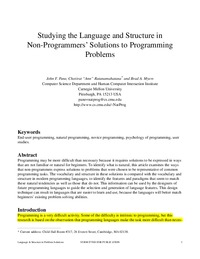 Diese Seite wurde seit 6 Jahren inhaltlich nicht mehr aktualisiert.
Unter Umständen ist sie nicht mehr aktuell.
Diese Seite wurde seit 6 Jahren inhaltlich nicht mehr aktualisiert.
Unter Umständen ist sie nicht mehr aktuell.
 Zusammenfassungen
Zusammenfassungen
 Pane found that participants
rarely used explicit looping and
always used one-sided conditionals.
Pane went further, to characterize the
style of programming that the participants
used. He found that over half
of the participants’ task statements
were in the form of production rules,
as in the example. He also saw the use
of constraints and imperative statements,
but little evidence of object-oriented
thinking. Participants did talk
about accessing behaviors built into
an entity, but rarely from the perspective
of that entity; instead, it was from
the perspective of the player or the
programmer. He found no evidence of
participants describing categories of
entities (defining classes), inheritance,
or polymorphism.
Pane found that participants
rarely used explicit looping and
always used one-sided conditionals.
Pane went further, to characterize the
style of programming that the participants
used. He found that over half
of the participants’ task statements
were in the form of production rules,
as in the example. He also saw the use
of constraints and imperative statements,
but little evidence of object-oriented
thinking. Participants did talk
about accessing behaviors built into
an entity, but rarely from the perspective
of that entity; instead, it was from
the perspective of the player or the
programmer. He found no evidence of
participants describing categories of
entities (defining classes), inheritance,
or polymorphism.Programming may be more difficult than necessary because it requires solutions to be expressed in ways
that are not familiar or natural for beginners. To identify what is natural, this article examines the ways
that non-programmers express solutions to problems that were chosen to be representative of common
programming tasks. The vocabulary and structure in these solutions is compared with the vocabulary and
structure in modern programming languages, to identify the features and paradigms that seem to match
these natural tendencies as well as those that do not. This information can be used by the designers of
future programming languages to guide the selection and generation of language features. This design
technique can result in languages that are easier to learn and use, because the languages will better match
beginners’ existing problem solving abilities.
Von John F. Pane, Chotirat Ann Ratanamahatana, Brad Myers im Text Studying the Language and Structure in Non-Programmers’ Solutions to Programming Problems (2001)  Dieser Text erwähnt ...
Dieser Text erwähnt ...
 Personen KB IB clear | Allen Cypher , J.-M. Hoc , A. Nguyen-Xuan , Jakob Nielsen , Ben Shneiderman , David Canfield Smith , Elliot Soloway , Jim Spohrer | |||||||||||||||||||||||||||||||||||||||||||||
 Aussagen KB IB clear | Programmieren ist schwierig | |||||||||||||||||||||||||||||||||||||||||||||
 Begriffe KB IB clear |  Algorithmus Algorithmus algorithm
, Cobol
, algorithm
, Cobol
,  Computer Computer computer
, HCI/MMI (Human-Computer-Interaction)Human-Computer-Interaction
, computer
, HCI/MMI (Human-Computer-Interaction)Human-Computer-Interaction
,  Programmieren Programmieren programming
, Programmieren für KinderProgramming for kids
, Programmiersprachenprogramming languages
, programming
, Programmieren für KinderProgramming for kids
, Programmiersprachenprogramming languages
,  Sprache Sprache language
, Syntax
, language
, Syntax
,  Usability Usability Usability
, Usability
,  User Interface (Benutzerschnittstelle) User Interface (Benutzerschnittstelle) User Interface User Interface
| |||||||||||||||||||||||||||||||||||||||||||||
 Bücher |
| |||||||||||||||||||||||||||||||||||||||||||||
 Texte |
|
 Dieser Text erwähnt vermutlich nicht ...
Dieser Text erwähnt vermutlich nicht ... 
 Nicht erwähnte Begriffe | blockbasierte Programmierumgebungen, Fortran, Semantik |
 Tagcloud
Tagcloud
 Zitationsgraph
Zitationsgraph
 Zitationsgraph (Beta-Test mit vis.js)
Zitationsgraph (Beta-Test mit vis.js)
 Zeitleiste
Zeitleiste
 5 Erwähnungen
5 Erwähnungen 
- Paving the Way for Computational Thinking - Drawing on methods from diverse disciplines - including computer science,
education, sociology, and psychology - to improve computing education. (Mark Guzdial) (2008)


- Making Software - What Really Works, and Why We Believe It (Andy Oram, Greg Wilson) (2010)

- Visual Program Simulation in Introductory Programming Education (Juha Sorva) (2012)


- Learner-Centered Design of Computing Education - Research on Computing for Everyone (Mark Guzdial) (2015)


- Programming Paradigms and Beyond (Shriram Krishnamurthi, Kathi Fisler) (2018)


 Volltext dieses Dokuments
Volltext dieses Dokuments
 |  Studying the Language and Structure in Non-Programmers’ Solutions to Programming Problems: Artikel als Volltext ( Studying the Language and Structure in Non-Programmers’ Solutions to Programming Problems: Artikel als Volltext ( : :  , 256 kByte; , 256 kByte;  : :  2021-03-21) 2021-03-21) |
 Anderswo suchen
Anderswo suchen 
 Beat und dieser Text
Beat und dieser Text
Beat hat Dieser Text während seiner Zeit am Institut für Medien und Schule (IMS) ins Biblionetz aufgenommen. Beat besitzt kein physisches, aber ein digitales Exemplar. Eine digitale Version ist auf dem Internet verfügbar (s.o.). Es gibt bisher nur wenige Objekte im Biblionetz, die dieses Werk zitieren.













 Biblionetz-History
Biblionetz-History